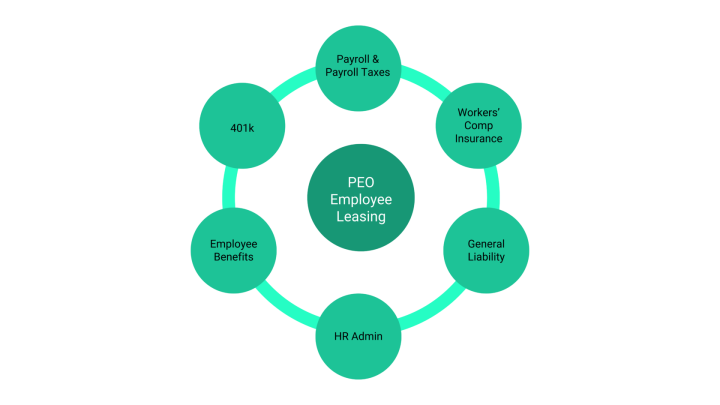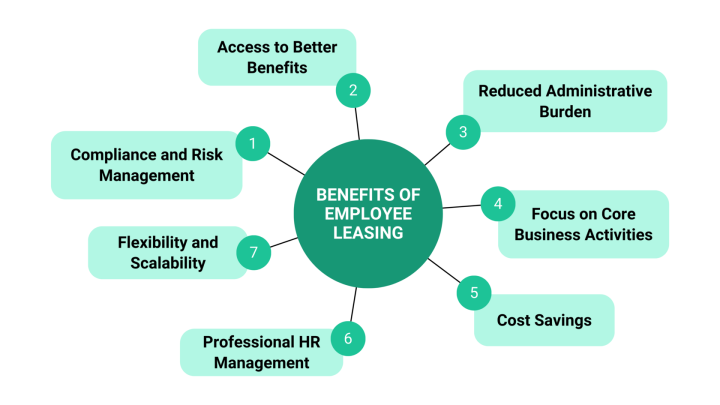Every business owner wants a star team of specialists working for the sake of their success every day. But in reality, hiring and managing that team may turn into a hassle. Recruitment, onboarding, provision of working space and equipment, taxation, contractual arrangements, social benefits, paid leave, and so on – all these words are every employer’s nightmare.
The good news is that there is a shortcut to fulfilling your staffing needs without a significant strain on your administrative resources. The name of that solution is employee leasing – an innovative hiring model that quickly gains popularity. You’re probably already familiar with the concept of leasing in the context of hardware or equipment rent for specific business purposes. Well, it works pretty much the same way with employees. This article will examine the nuances of labor leasing and show its pros, cons, and business situations in which it may suit your needs.
What Is Employee Leasing?
Let’s begin with the definition of staff leasing to clarify what this service means. In a nutshell, the term ‘leasing’ means renting an object or resource for a predetermined period without actually owning it. Similarly, when you’re leasing staff, you don’t act as their full-time official employer and only use their services for a pre-negotiated duration.
Employee leasing services emerged in the middle of the past century but acquired broad popularity only in the 21st century in response to the rising costs of full-time hiring and costly pension plan obligations. This service model presupposes that you get the needed number of properly qualified employees to work on your project from the staff leasing company you hire.
What is a staff leasing company? It is a firm that acts as all the employees’ official employer, so they are included in its payroll and get their taxes and benefits covered on its behalf. Therefore, you get only the workforce, while the leasing provider handles all the HR and payroll paperwork.
The hiring arrangement may be regarded as leasing if it meets the following criteria:
- Employee is assigned to the hirer by their full-time employer.
- Employee is integrated into the hirer’s daily business operations.
- Employee works in accordance with the hirer’s instructions and directives.
This way, a leased employee is permanently employed at a leasing company and may work on many consecutive projects for third-party hiring companies.
Staff Leasing vs PEO: What’s the Difference?
Staff leasing and professional employer organizations (PEO) used to be treated as identical hiring models, but they come with several notable distinctions. A PEO acts as your staff’s co-employer and usually manages staff members on a long-term employment basis. This way, workers hired via the PEO model start and end their work in your company with no continuation of contractual arrangements with the PEO.

Employee Leasing in PEO Ecosystem
These nuances determine the main differences between leasing and PEO:
- Employment duties. A leasing provider handles all duties on its own, giving you the leased staff for short-term contractual tasks only. When using PEO services, you share the employment duties with the provider (though a broader scope of administrative duties is negotiable for an extra fee).
- Legal presence. While a leasing company only gives you staff for the completion of temporary tasks, PEOs help you establish a firm presence in jurisdictions where you have no legal entity. Therefore, a PEO is often considered in situations when businesses want to enter new labor markets and expand their presence.
- Contracts. As discussed above, a leasing provider may allocate their staff to various projects. Thus, one employee may have many allocations during their work for the leasing company. In the PEO case, the contract starts and ends with one client, as most employees are hired on demand.
Based on these differences, you should make the right decision to choose employee leasing or PEO by taking into account your business needs. Here are a few parameters that will help you decide:
- If you need a long-term employee, a PEO would be better. Short-term staff engagements are easier to handle on the leasing model.
- Leasing is better if you don’t want to mess with new employee hiring at all. PEO involves co-employment, so there will be certain legal arrangements on your part. At the same time, you will have more control over staff.
- Hire leased staff if you need temporary specialized skills that are not mission-critical to your core business tasks.
- Use PEO services when you need highly qualified experts, as PEOs offer better insurance and retirement plans, so they attract better talent.
- Opt for PEO services if you engage staff across jurisdictions and want to avoid the legal troubles of international hiring.
It also makes sense to note that PEO services cost more, so they suit businesses with a larger staffing budget. Yet, PEOs usually offer a greater diversity of covered services, which is a bonus for the additional financial commitment.
Finally, a PEO staffing arrangement is more suitable for companies striving for better staff integration, as leased staff is usually less integrated into the company’s core business structure and culture.

Benefits of Employee Leasing
Whenever you decide to turn to an employee leasing company, you may expect to reap the following advantages of using leased staff:
- Flexible staffing
All businesses dream of flexibility in staff management. If you need only five developers for two months and then project your workload to decline and be enough for two developers only, how can you deal with these fluctuations? Leasing is an answer, as it provides for your specific staffing needs and can close current staffing gaps without expensive long-term commitments. - Reduced HR workload
If you continually need varied employees for different tasks and project stages, only an HR team may ensure that you have the right number of properly skilled staff on board at any given moment. However, the thing is that HR managers and recruiters are also costly members of your in-house team, and you may not always be able to keep that staff permanently. Leasing is also beneficial in this aspect, as the provider will handle all HR tasks. - Cost savings
Recruiting, training, social benefits, and offboarding are very costly tasks for any business. They require separate staff to deal with these procedures, which comes with many legal nuances you surely want to avoid. Thus, by leasing staff, you delegate all those responsibilities to a competent third party. - Access to a global talent pool
As soon as you realize you need extra staff, you may be limited in hiring decisions by your geography and industry specifics. In some cases, companies are literally ‘blackmailed’ by scarce specialists available in their locations, knowing that they are the only ones who can do the job well. So, why yield to the pressure of scarcity if you can expand your scope of talent search to the whole world? Find a leasing company that has the talent you need and partner with it – the modern digitized world has made it possible. - Minimal legal liability
When you lease staff, only your leasing provider is responsible for taxation, payroll, and labor law compliance. Your task is to cover the expenses for this company’s services and your leased employee’s plain rate without legal strings attached.
All these benefits are really worth serious consideration. They address the challenges that most modern businesses encounter in the domestic and international labor markets and remove the legal hassle aspect from the hiring process.
Risks of Leased Employees
However, it would be too quick to say that employee leasing is a panacea to all business troubles. As with any other hiring model, you need to factor in some potential drawbacks.
- Lack of control. The most troubling aspect of using employee leasing services is a lack of control over the hired staff. Things work differently compared to your in-house staff management, as in most cases, the team works remotely and is only partly involved in your business processes. Therefore, you should be ready for limited control over staff hiring, training, and onboarding processes that you can’t affect in any way.
- Sensitive data. Another source of risk is the need to share access to sensitive data and business secrets with remote staff working outside your protected IT infrastructure. There is no efficient remedy for confidentiality and privacy risks, as the only established form of protection is signing an NDA contract with all leased employees.
- Vendor lock-in. Once you sign a leasing contract with a company, you become dependent on it in terms of staff provision. This arrangement may not be problematic when all staff members work fine, but the lock-in can turn into a hurdle if you realize the current provider can’t meet all your staffing needs.
- Disputes. As staff leasing remains a gray niche in employment law, it’s pretty common for leasing companies and their employees to raise legal disputes about contractual terms, coverage of benefits, and contract termination.
There’s no guarantee that you will face any of these drawbacks when working with a leasing company. In many cases, a leasing contract is a smooth flight for all parties. Yet, things happen, and you should be ready to handle any of the discussed issues with your leasing partner or its employees.
How to Find the Best Provider of Employee Leasing Services?
Choosing the right employee leasing service provider can be a difficult task for some companies. Focus on the following criteria when reviewing vendors:
- Talent pool and specialization
Before hiring a leasing partner, you should make sure it has staff competent in your business domain, e.g., EdTech, real estate, or web development. - Transparency of hiring arrangements
It’s very important to ensure the leasing firm’s hiring processes and contractual arrangements are legal, clear, and transparent to all parties. This aspect is key to the avoidance of litigation and lengthy disputes. - Compliance with labor laws
The gist of resorting to leasing services is to ensure compliant and flexible short-term hiring. That’s why you should double-check that your provider complies with local labor laws and executes all staff leasing operations legally. - Software, hardware, and infrastructure
You will need to integrate your leased staff into your business processes, but they will work on the provider’s territory. Thus, PEO provider should have workforce management, payroll, and other systems enabled. - Quality of communication
The way your leasing partner’s representatives respond to your inquiries and handle your concerns will show how your working relationship will go. It’s much easier to work with quick and responsive support staff communicating with clients via a variety of channels.
In addition to five criteria mentioned above, you can use the following checklist to understand whether the provider of employee leasing is credible and deserves your attention.
- How long has the company been in the staff leasing industry?
- Does it have the necessary software to facilitate employee screening, management, and payroll?
- Does it have IT knowledge and necessary niche experience?
- What do their previous clients say about working with them?
- Who is the company’s payment provider?
- Does the payroll occur on time and in line with the negotiated agreements?
- Does the company have clear and transparent billing and invoicing procedures?
- What verification documents does the company provide to client companies?
Finally, it’s critical to weigh several important considerations on your part, such as your available budget for leasing services and your company’s values, goals, and business priorities. You should balance your needs and resources with the credibility and reputation of leasing companies you’ve located in the online space. Don’t go for the first best variant, as it may undermine the quality of your working relationship and prevent you from reaping the full spectrum of staff leasing benefits.
Conclusion
As you can see, employee leasing is a very flexible staffing solution that may address all your concerns, such as staff retention or meeting inflationary issues, without disruptions of core business processes. This hiring model can relieve the burden of HR management from your in-house staff, thus letting you concentrate on strategic tasks and avoid performance gaps. Make sure you make proper legal arrangements with your professional employee leasing agency, and keep the disadvantages of this model in mind when planning your hiring processes. If these issues are addressed, the rest won’t be a problem.




